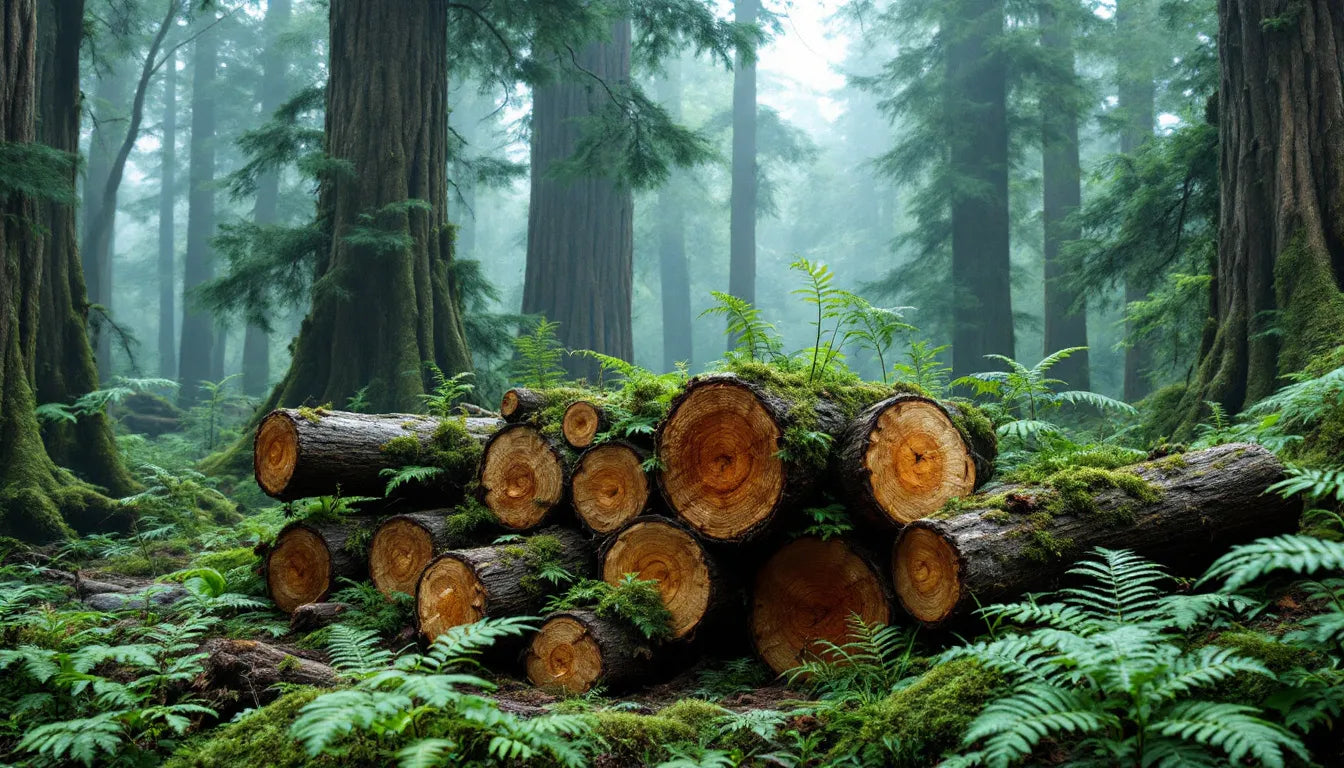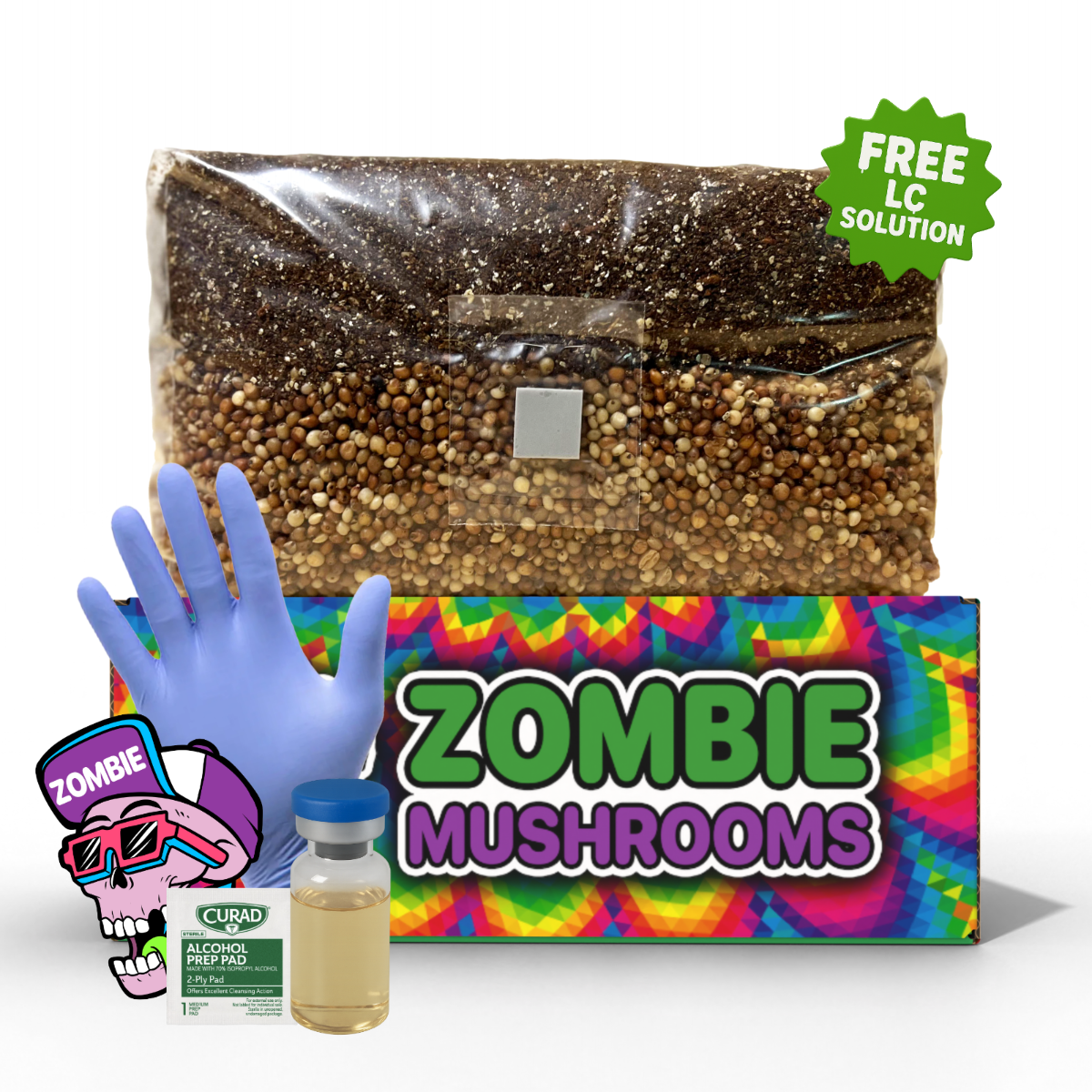⬇️ Prefer to listen instead? ⬇️
- Studies show shiitake mushrooms contain ergothioneine and lentinan, which offer antioxidant and immune-boosting health benefits.
- Outdoor log cultivation can yield mushrooms for up to 4 years with proper maintenance.
- Pasteurized sawdust blocks allow for much quicker harvests—ready in as little as 8 weeks.
- Shiitake logs need cold water soaking to trigger fruiting, mimicking natural seasonal changes.
- Shiitake log kits simplify home cultivation, especially for beginners looking for low-effort results.
Shiitake mushrooms have long been valued for their rich, savory flavor and health benefits. If you want to grow food in your backyard or try it in your kitchen, growing shiitake mushrooms is a good way to grow your own food. This guide will tell you what you need to know - how to grow them, setting up where to grow them, putting them in logs or other materials, and getting lots of mushrooms - using tools like a shiitake log kit to make it easier.

Why Grow Shiitake Mushrooms?
Shiitake mushrooms (Lentinula edodes) are liked around the world not just for their rich umami taste but also because they are good for you and can help with health. Used in fancy cooking, they're full of good things, including B vitamins (niacin and pantothenic acid), copper, dietary fiber, and antioxidants and selenium (USDA, 2020; Mau et al., 2001). One of their special parts, lentinan, is said to help your immune system and fight tumors (Gu & Sivam, 2006).
Benefits of Growing Shiitake at Home
If you are a home gardener, hobbyist, or live in a city, growing shiitake mushrooms has many benefits
- Quality and freshness: Taste best when you pick them, better than store-bought.
- Self-sufficiency: Grow your own. Don't need to buy from stores as much.
- Environmental advantage: Good for the environment. Less pollution from shipping, less waste from packaging, and better for the earth.
- Cognitive and immune support: Help your brain and immune system. said to help with stress and your immune system.
- Cost savings over time: Save money later. After you set things up - especially with a shiitake log kit - you can get free mushrooms for years.

Understanding Shiitake Mushroom Cultivation
Shiitake mushrooms grow naturally on dead hardwood trees in forests in East Asia, especially Japan and China. People have grown them there for a very long time. Unlike oyster mushrooms—which grow fast on many things—shiitake mushrooms need strong hardwood or sawdust with extra food added. This means growing them is a bit more work but you can get mushrooms for longer and they taste better.
Indoor vs. Outdoor Growing
You can grow shiitake mushrooms in different places, depending on where you live
- Indoors: Good for cities or places with very hot or cold weather. People often use bags or blocks of sawdust.
- Outdoors: More like how they grow in nature. Hardwood logs put in shady spots give you mushrooms each season for years.

Step 1: Deciding Your Growing Method
How you grow shiitake mushrooms depends on what you want, how much space you have, how much time you have, and where you live. The main ways are growing on logs and growing in sawdust.
Log Cultivation
Growing on logs is the old way and is better for the earth.
Good things
- Get mushrooms for 3–5 years from the same log
- Not much work after you start
- Like how they grow in nature
Bad things
- Takes 6–12 months before you get mushrooms
- Best to start at certain times of year (late winter to early spring)
Good for
- Home gardeners, people living on farms, and outdoor growers with shady places
- People who want mushrooms for a long time
Tools & Things you need
- Hardwood logs (oak, maple, or beech)
- Drill with a 12mm bit
- Tools to put the mushroom stuff in (plunger or spawn gun)
- Mushroom spawn (plug or dowel)
- Cheese wax or beeswax
- Shiitake log kit (log with holes, spawn, wax—all in one)
Sawdust Substrates
This way is good for indoors and uses bags or blocks of sawdust with food added.
Good things
- Mushrooms fast (ready in 8–12 weeks)
- Can grow all year inside
- Good if you don't have much space
Bad things
- Need to control wetness, temperature, and air
- Don't get mushrooms for as long as logs
Good for
- Indoor growers, people in apartments, people who want mushrooms for cooking
- People who want mushrooms quickly
Tools & Things you need
- Sterile grow bags or containers
- Sawdust with extra food
- Shiitake grain or sawdust spawn
- Spray bottle or humidifier
- Grow tent or monotub setup

Step 2: Preparing the Substrate
If you grow shiitake mushrooms on a log or in sawdust, getting the base ready is very important.
Preparing Logs
Picking the Right Wood
- Best wood: Oak, beech, hard maple—strong hardwoods feed shiitake mushrooms for years.
- Wood to stay away from: Softwoods or woods that smell strong (pine, cedar) — these have stuff in them that stops mushrooms from growing.
Log Size
- Across: 3–8 inches
- Long: 3–4 feet
Cutting & Resting
- Cut logs in late winter or early spring when they have lots of sap but before new growth starts.
- Let logs sit in a shady spot for 2–4 weeks; this lets bad stuff go away but keeps water inside.
Preparing Sawdust Blocks
Good Mix
- 90–95% hardwood sawdust
- 5–10% wheat bran or rice bran for food
Heating It Up
- Heat the mix to 160°F–180°F for 1–2 hours. This kills bad bugs but keeps good stuff.
Easy Way
- Buy sawdust blocks that are already heated or have mushrooms growing in them from places online like Zombie Mushrooms.

Step 3: Putting Spawn in Logs or Substrate
Putting spawn in is when you add shiitake spawn to what you are growing in.
Logs: How to Put Spawn In
- Drill Holes: Make holes about 6 inches apart all around the log in a zig-zag pattern. You need about 40–50 holes for each log.
- Put Spawn In: Use plug spawn (wooden pieces with mushroom stuff in them) or sawdust spawn. Push them in with a hammer or tool.
- Cover Holes: Put melted wax over each hole to keep bugs out and stop it from drying out.
- Write on the Log and Date them—this helps you see how they are growing.
Tip: Wear gloves so you don't get bad stuff in there.
Sawdust Bags or Blocks
- Mix Well: Spread grain spawn all through the sawdust mix.
- Put in Bags: Put the mix in special grow bags or buckets with holes.
- Seal & Keep: Close them up and keep in a clean, dark place that is 65–75°F for growing.
This way, the mushroom stuff spreads fast because it touches more of the sawdust.

Step 4: Waiting for Growth
This time is when you can't see much happening, but the mushroom stuff is growing inside, making white threads needed for mushrooms.
Waiting for Logs
- Time: 6 to 12 months
- Place: Shady outdoor place protected from wind
- How to put them: Stack logs like a cabin or lean them like a teepee so air can flow
- Keep Wet: Water each week or cover with cloth if it's dry
Waiting for Sawdust Blocks
- Time: 8–12 weeks
- Temperature: 68–75°F
- Place: Dark place with steady wetness
- How to Know It's Working: White, fuzzy stuff should cover it by 12 weeks
Watch out for mold that is green or black and throw away any bad blocks.

Step 5: Getting Mushrooms to Grow
When it's all grown inside, you can get mushrooms to grow by surprising them into making mushrooms.
Logs: Getting Mushrooms
- Soak in cold, clean water (bathtub or big tub)
- Time: 12–24 hours
- Stand logs up or lean them against something
- Mushrooms should start in 5–10 days
Soak again every 6–8 weeks to get more mushrooms—some logs make mushrooms 3 times a year!
Sawdust Blocks: Getting Mushrooms Indoors
- Move to a place for growing mushrooms (grow tent, clear box with holes)
- What you need
- Wetness: 85–95%
- Temperature: 60–70°F
- Light: Not direct sunlight or grow light for 12 hours a day
- Air: Use small fans or wave air to stop bad air from building up
- Spray water on it 1–2 times a day to keep it wet
Mushrooms usually start in less than 2 weeks; full mushrooms in 5–10 days.

Step 6: Picking and Keeping
Knowing when and how to pick mushrooms is important for best taste.
When to Pick
- Tops should be firm and start to flatten out, but not curl up
- Underside should be open but not turning dark
How to Pick
- Hold the mushroom near the bottom and twist gently
- Don't pull hard, it can hurt the mushroom stuff inside
- Use a clean knife if you need to, especially for groups
Keeping Shiitake Mushrooms
- Fresh: Keep in an open or paper bag in the fridge (7–10 days)
- Dried: Slice and dry at 110°F until crispy; keep in closed jars for up to 12 months
- Frozen: Cook a little before freezing to keep them good

Tools & Kits to Make It Easier
To make growing shiitake mushrooms easier, think about using kits and tools made for beginners
Shiitake Log Kit
- Has: Log with holes, mushroom spawn plugs, wax, and easy directions
- Best for new growers who don't have tools
Sawdust Grow Kit
- Has a sawdust block with mushrooms already growing, usually ready to grow more in a week or two
- Good for indoor growers or first-timers without a garden
Better Tools
- Tool to put spawn in logs faster for big log growing
- Sprayers that control wetness automatically
- Boxes or mini greenhouses for lots of indoor mushrooms
Check with places like Zombie Mushrooms for deals on shiitake log kits and indoor sawdust kits.

Health & Cooking with Shiitake Mushrooms
Shiitake mushrooms are full of good stuff and low in calories, one of the best healthy foods.
Good Things Inside (per 100g)
- Calories: ~34
- Protein: 2.5g
- Lots of B-vitamins (niacin, pantothenic acid)
- Antioxidants: Selenium and ergothioneine (Mau et al., 2001)
Cooking Ideas
- Cook in butter and garlic like a steak
- Put in ramen, risottos, or noodles for good taste
- Dry and put in soups or tea for extra health
- Roast with herbs for crispy vegan "bacon"
They are chewy and meaty, good in vegetarian meals, soups, and stews that cook for a long time.

Common Problems and Tips
Growing them well comes with doing it, but here are tips to learn faster
- Bad stuff growing? Clean tools, clean sawdust, and seal things well to stop it.
- Mushrooms not growing? Cold water your logs or make it wetter and more airy inside.
- Bugs outside: Lift logs off the ground and cover with mesh.
- Dry places: Water logs each week or cover with cloth to keep wet.
And most of all—be patient and interested. Nature takes time, and your shiitake mushrooms will pay you back over time.
Start Growing Shiitake!
From their good, fancy taste to the happiness of growing your own food, growing shiitake mushrooms is a great project for cooks, gardeners, and people who love nature. Whether you get a shiitake log kit for easy outdoor growing or try growing indoors with sawdust and spawn, you will learn how food and mushrooms can grow together. Try it, and grow mushrooms that are fresh, tasty, and full of life.
Citations
- Kalac, P. (2013). A review of chemical composition and nutritional value of wild-growing and cultivated mushrooms. Journal of the Science of Food and Agriculture, 93(2), 209–218.
- Mau, J. L., Lin, H. C., & Chen, C. C. (2001). Antioxidant properties of several medicinal mushrooms. Journal of Agricultural and Food Chemistry, 49(11), 5461–5467.
- Gu, Y. H., & Sivam, G. (2006). Cytotoxic effect of edible and medicinal mushrooms on human colon cancer cells. Cancer Letters, 221(2), 209–220.



